18:39S 173:59W Cook Islands and Niue

Toucan
Conor & Marion Wall
Tue 4 Oct 2011 02:08
|
Well, a lot of water has passed under ‘Toucan’ since I wrote the last blog
which I believe was in Bora Bora at the end of our time in the Society
Islands. We are currently in Tonga and I will deal with this group
when we have finished here. From Bora Bora we sailed firstly to Aitutaki (I bet
you can’t find that in the Atlas), its just under 500 miles west of Bora Bora.
The Island of Aitutaki has a long narrow entrance that was blasted out of the
coral with dynamite and is very shallow. Only shallow draft boats can go there
and Toucan with her lifting keel had no problem. However the the chart for
this island is approximately 400 meters out of place with our chart plotter(we
have found this to be the case with previous Islands) and as we approached the
entrance it appeared that we were about to run into the coral that surrounds the
Island. There were no entrance markers and as we approached the coral reef we
could not see the entrance until we were about 200 meters away from it. Imagine
trying to find the entrance to Christchurch harbour with absolutely no land
marks or raised land to guide you in, only breaking waves on the mostly hidden
coral. Luckily for us one of the boats ahead of us had given us the correct
co-ordinates. A French boat that arrived the following day to us actually ran on
to the reef 400 meters or so to the south of the entrance. They did not have the
correct co-ordinates and were relying on the GPS and their chart plotter.
However they managed to back off the reef and no serious damage was done to
their plywood boat. It turned out that the skipper knows the husband of my niece
who is French and lives in Southern Brittany. Small world.
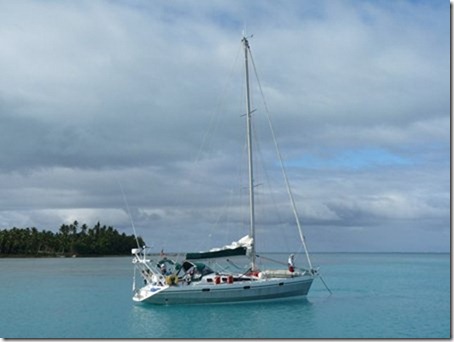 Toucan anchoring in the calm waters inside the reef at
Aitutaki.
Aitutaki is a charming place and the people extremely welcoming and
friendly, customs formalities was a breeze and there are no dogs on the Island.
The story goes that a former Chief or King was bitten by a dog and so they were
banned. We spent 5 days here in the sheltered lagoon and hired a scooter to tour
the small island following a night out at a hotel complexes for a night of
feasting and entertainment. The dancing and singing from this Island rates as
one of the best in Polynesia and the dancers win much of the competitions in the
annual events mainly as their dancing is more authentic that the rest.
Apparently.
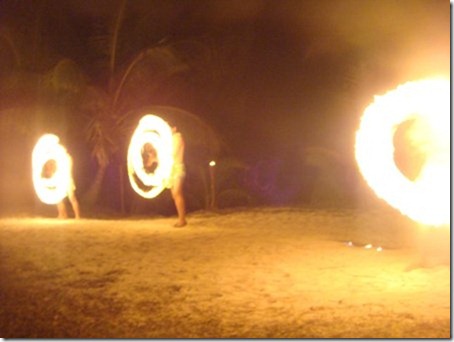 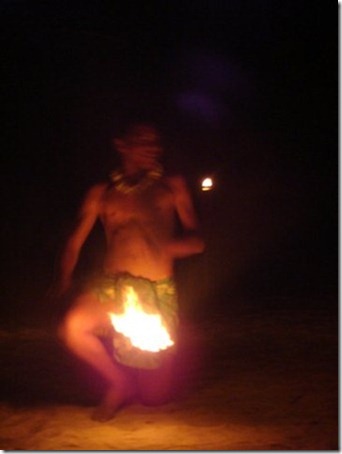 Ouch!
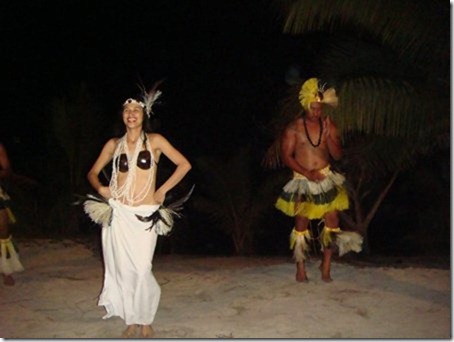  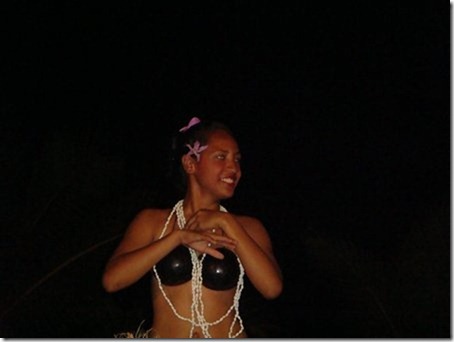 You can almost see the hips move even in the still photos, coconut
shells are all the fashion with female dancers.
 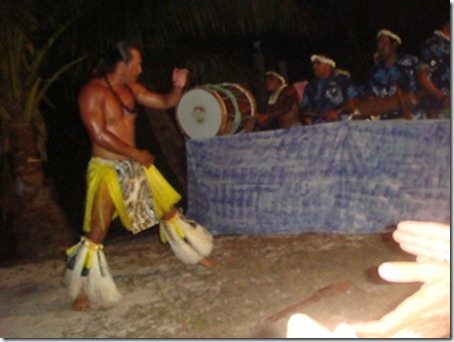 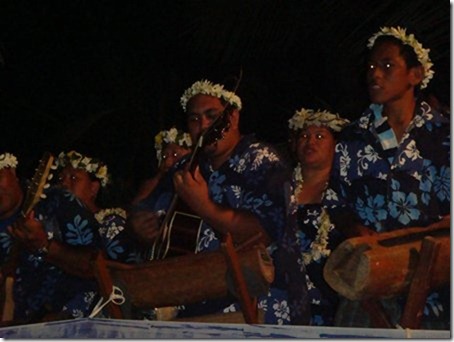 Amazing melodic sounds with mostly primitive
instruments.
Unfortunately we forgot to take our camera on the scooter tour so no photos
for the rest of the Island. We were most disappointed not to have had the camera
particularly as we stumbled across a unique Marine Research facility run by one
man who has spent his life studying and experimenting with Clams. He is
currently sponsored by the Australian Government but really the whole operation
is run on a shoe string. Some of what he does entails collecting clam eggs and
raising the young clams in tanks until they are old enough to be put back into
the coral to grow and multiply. Unfortunately the locals still eat clams and
some years ago had almost wiped them out completely due to over fishing.
He also experiments with the colour of the clams, you probably don't know
but when you see a clam in the sea they have brilliant colours around the
section of the clam that opens and closes, some are blue some are red some are
green etc. and they look amazing as you snorkel over them. This man has taken
the colour to another dimension by taking a clam of a particular colour and
putting it through a blender, then feeding it back to a group of a different
colour over a period of a few days. These clams then take on a completely new
and often stunning colour which have to be seen to be believed. They really are
like looking at works of art. It might be possible to Google something about
this research establishment although the man dedicated to the clams will have no
knowledge of computers, hopefully someone else has taken the trouble.
Before we left Aitutaki the customs officer asked us if we could take some
goods to the next island on our travels, Palmerson, as we had indicated that
that would be our next port of call. I asked him what would happen if the
weather turned against us and we could not make it there, he said not to worry
and he would ask another boat. Palmerston you will remember from a previous blog
is the Island with only 63 inhabitants and all with the same Surname (bet you
can’t work that one out) and the island where our friends Frank and Gail lost
their lovely yacht to the reef a few weeks earlier. As it turned out the weather
did turn against us and as we approached Palmerston and we had to divert to our
next Island on our route. We were only 25 miles from Palmerston but as we
approached the winds picked up and turned Northerly. This made the island
dangerous as the only safe place to anchor was now exposed. Frank lost his boat
for this reason coupled with the fact that the holding buoys laid down by the
local community were not strong enough.
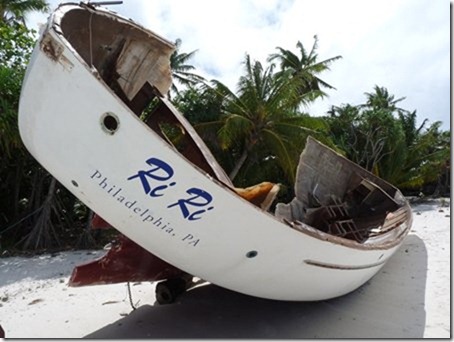 Ri Ri completely stripped of all her equipment by the locals within
weeks of her being washed on to the reef.
This photo was taken by another friend who agree to take the goods (which
turned out to be 30 kg of vegetables). They had a very uncomfortable and
worrying couple of nights anchoring in different locations in the lee of the
Island, a dangerous thing to do as the anchor has to be set in shallow water
close to the reef (remember the depth drops off from these islands to over 2
kilometers sometimes within only a few hundred meters). If the wind turns
suddenly you end up on the reef.
As you can see from the photo Ri Ri has been completely stripped of
anything of value. A lot of the salvaging was done whilst Frank was still on the
Island and I believe that he hopes to get a lot of what was saved sent to New
Zealand on the ship that calls to Palmerston four time per year. I have my
doubts as we have heard some strange stories about these people.
And so we continued sailing in a westerly direction for another 3 days with
some very strong winds and uncomfortable seas until we reached the Island of
Niue on Wednesday 7th September. Once again the anchorage is very exposed to
winds from the North and West but at least there there are some very well
maintained moorings and when we arrived there were already 8 boats and still at
least another 10 mooring buoys to chose from. Luckily again for us the winds
remained from the East for nearly all of our time on Niue. Unfortunately though
the day after we arrived a supply ship also arrived and took three days to
unload her cargo. The ship anchored off the rather small quay and took a stern
line ashore to keep the ship facing in the same direction. A small vessel towing
a barge plied to and fro to unload the containers one by one, sometimes in
almost impossible conditions with the ship rolling from side to side in the
swell.
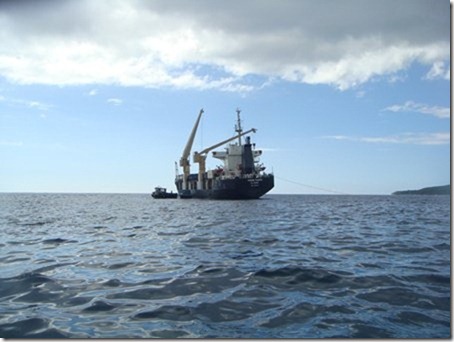 On one occasion a control line attached to a container broke free
and the container swung out of control. Men ran in every direction to avoid
being struck by the container. Finally the crane controller set it down, it
seemed a miracle from where I was watching from.
Whilst the ship was unloading our dinghy was not allowed to land on the
quay. Landing there was a completely new experience for us. We had to approach
the quay steps, Marion would then jump off before the wave washed her away and
climb up to the crane that lowered a hook down for me to grab. I would then hook
the dinghy to a lifting line that I had pre installed and then had to get on to
the steps myself before Marion would begin to hoist the dinghy. There was no
where else to land a dinghy so we lost three days waiting for the ship to
go.
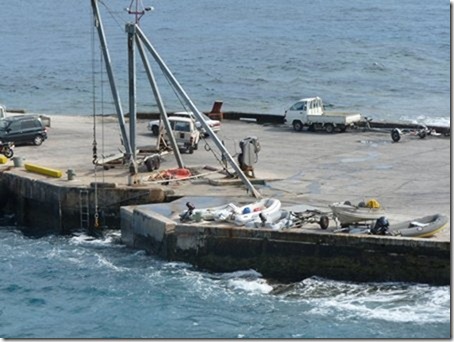 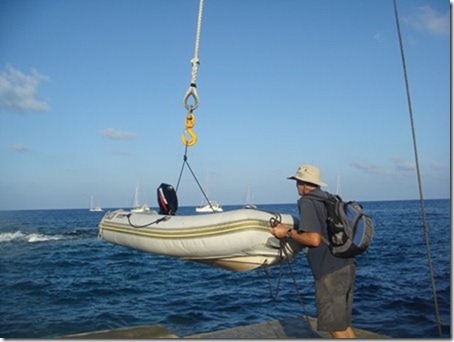 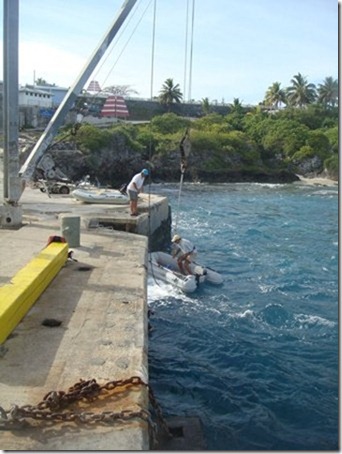 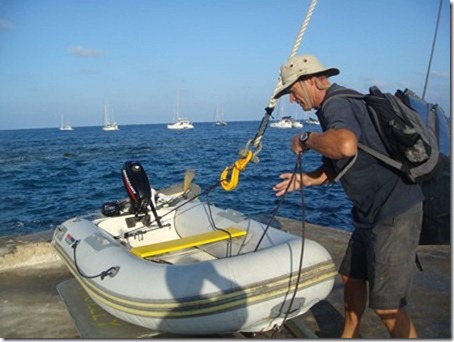 It worked well when there was no swell/waves but tricky, even
dangerous at other times.
We had a very nice time on Niue and hired a car to visit some of the many,
strange and natural features of this unusual island. There are no rivers on Niue
as the rock is porous and allows the rainwater to flow into the sea with
absolutely no sediment. This makes the waters around Niue one of the clearest
waters in the world and so making it a popular place for divers. There are also
some very strange caves and rock formations etc around the coastline but no
proper beach and the coastline mostly over 100 feet and more above sea level. No
natural harbour.
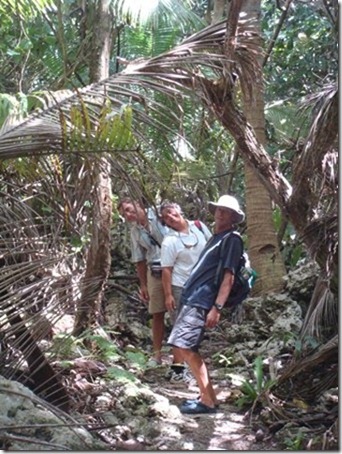 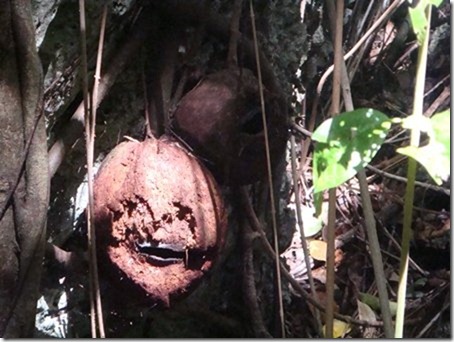 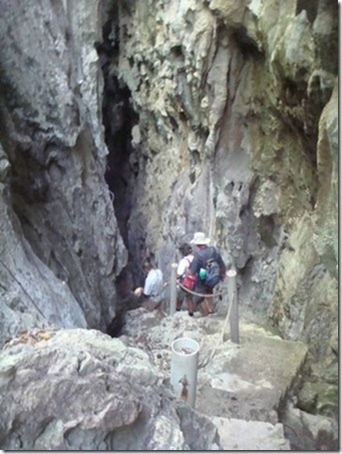 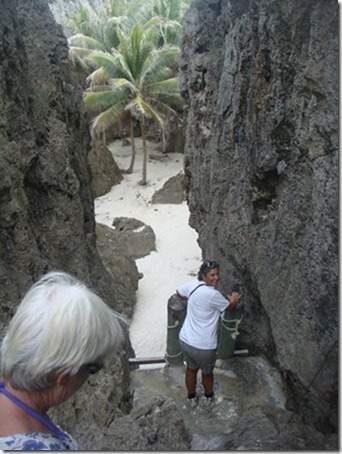   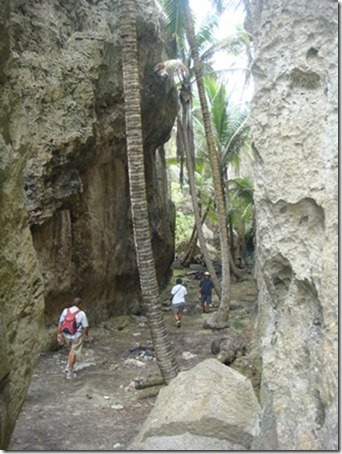 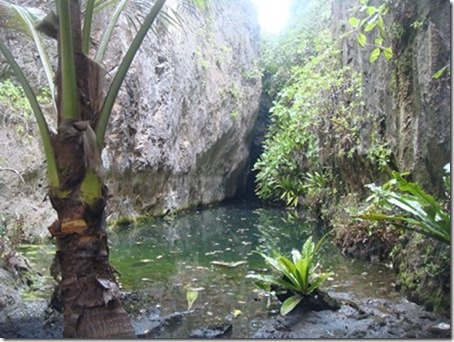 Fresh water pool only meters from the sea, yet not a sound of the
sea could be heard.
 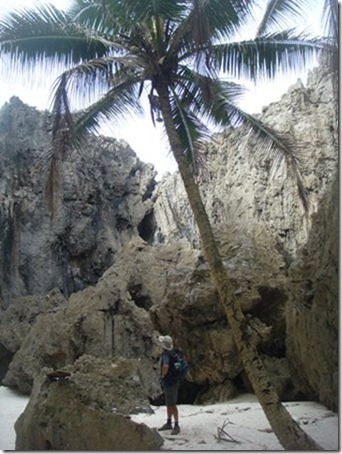  We could have been in the Sarah Desert.
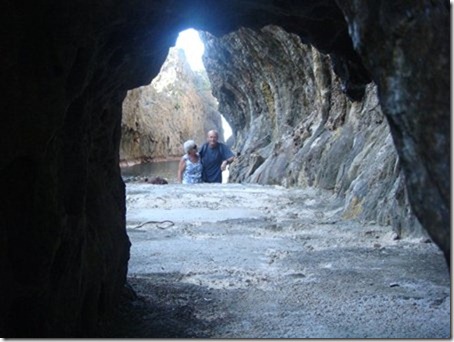  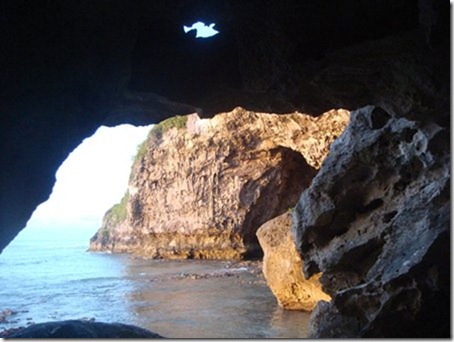  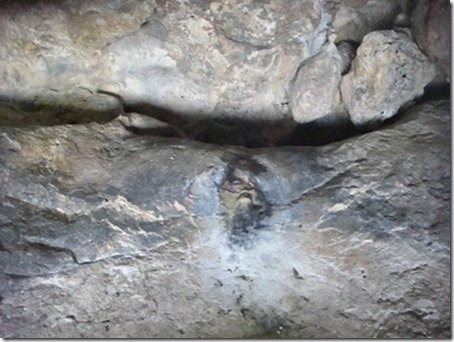  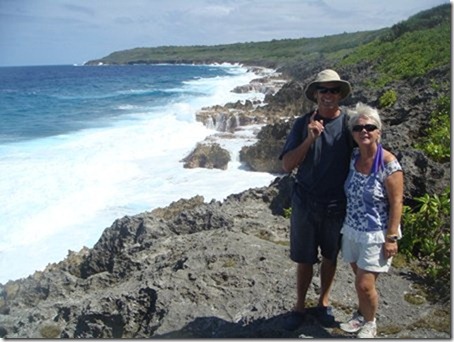 Niue is world famous for the whale watching and is one of only two places
in the world that allow you to swim with the whales. The other place being
Tonga. We saw a couple of whales on our arrival at the top end of the Island but
on one of our days there we took four young people from the whale research team,
that come each year to Niue, on a trip to the south of the Island to find a
whale and observe it’s movements and record the whale song. We were lucky enough
to find one but the team recognised it as one they had observed some days before
so we did not go too close and hence any photos that we took were not very good.
We did however learn an awful lot about the whale activity and felt enlightened
by the day.
 The whale watching team on Toucan.
Only one flight per week landing on the island so everything is still a bit
raw.
|